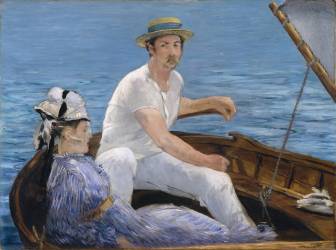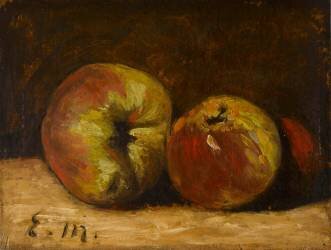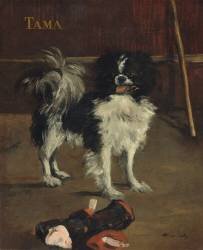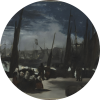Artwork of Edouard Manet
Edouard Manet, a key figure on the French art scene in the 19th century, left an indelible mark on the history of painting. His works, now exhibited in some of the world's greatest museums, including the Musée d'Orsay in Paris and the Metropolitan Museum of Art in New York, continue to fascinate and challenge, as in Young Man in a Majo Suit (1863, Metropolitan Museum of Art, New York), Portrait of Madame Michel-Lévy (1882, National Gallery of Art, Washington D.C.), Femme aux cerises / La chanteuse de rue (1862, Museum of Fine Arts, Boston), La Femme au perroquet (1866, Metropolitan Museum of Art, New York) and La musique aux Tuileries (1862, National Gallery, London).
His passion for art led him to defy convention and embrace the path of creation. His Déjeuner sur l'herbe (1863, Musée d'Orsay, Paris), presented at the Salon des Refusés in 1863, and Olympia (1863, Musée d'Orsay, Paris), caused a scandal and marked a turning point in the history of modern art. Manet established himself as a daring painter, overturning academic codes and paving the way for Impressionism, whose artistic circles he frequented, befriending Charles Baudelaire, Émile Zola, Henri Fantin-Latour, and other Impressionist painters such as Claude Monet, Edgar Degas and Auguste Renoir.
Throughout his life, Manet persevered in his quest for a new aesthetic. He explored different genres, from portraiture to still life and genre scenes. His paintings bear witness to his fascination with light, colour and movement, which he transcribed with his favourite models such as Berthe Morisot, Victorine Meurent or his partner Suzanne Leenhoff and their son Léon.
Biography of Edouard Manet
Edouard Manet's youth and training
Born in Paris in 1832, Édouard Manet grew up in a well-to-do bourgeois milieu. His father, a senior civil servant in the Ministry of Justice, and his mother, a diplomat's daughter, ensured him a comfortable life. Despite his average schooling, the young artist developed a taste for the arts very early on, encouraged by his uncle, a painting enthusiast who introduced him to art by taking him regularly to the Louvre. After an initial unsuccessful attempt to enter the Naval Academy, Manet made a sea voyage in 1848, during which he produced numerous sketches of his fellow students and officers.
On his return to France, and following a second unsuccessful entrance examination for the Navy, his family finally agreed that he should devote himself to an artistic career. In 1850, he entered the studio of Thomas Couture, a renowned academic painter. Long before the creation of controversial canvases such as his painting Le Déjeuner sur l'herbe (1863, Musée d'Orsay, Paris) or his painting Olympia (1863, Musée d'Orsay, Paris), the young painter spent six years learning traditional painting techniques and copying the Old Masters at the Louvre. Thomas Couture also encouraged him to travel and discover European museums and the great masters. Manet visited Italy and the Uffizi Museum, but also Germany and the Netherlands, where he was particularly interested in the works of Velasquez, Fra Filippo Lippi, Titian, Goya, Rembrandt and Hals.
From this time onwards, he painted pictures that bore witness to his artistic personality and influences. In 1856, after leaving Couture's studio, whose academicism he no longer shared, he moved into his own studio. Manet then set about creating his own paintings, exploring different genres, from portraits to genre scenes and still lifes. Among Manet's early works that already heralded the painter's innovative style were The Absinthe Drinker 1859, considered his first original canvas, and The Child with Cherries, an oil on canvas with a tragic fate, the model, a young man of 15, committing suicide in the artist's studio, which inspired a poem by Baudelaire, whom Manet met the following year.
It was also during these years, in 1849, that Edouard Manet met Suzanne Leenhoff, a young woman of Dutch origin who gave him piano lessons and became his partner in 1852. From this union outside marriage a son was born called Léon Koëlla, the young boy being regularly taken as a model by the painter throughout his life, as in Détail de Léon Leenhoff (1859, Musée des Beaux-Arts de Lyon), L'Enfant à l'épée (1861, Metropolitan Museum of Art New York) or in the portrait Les Bulles de savon (1867, Musée Calouste-Gulbenkian).
The beginnings and quest for recognition for Edouard Manet
In Paris in 1859, the young painter Édouard Manet, strengthened by his newly acquired independence thanks to the opening of his studio on rue de Douai, embarked on the creation of a body of work that would mark a turning point in his career. His style, influenced by Courbet's realism, broke with the academic conventions of the time. Manet chose to depict modern life and his contemporaries, an approach reflected in his portraits and genre scenes.
Despite his talent and because of his audacity, the jury of the 1859 Salon refused his first painting at the Salon Officiel, The Absinthe Drinker. This failure did not discourage the young artist. He continued to explore new avenues, notably drawing inspiration from Spanish masters such as Goya and Velasquez.
Manet's perseverance eventually paid off. In 1861, the Salon accepted two of his paintings: The Spanish Singer and Portrait of Mr and Mrs Auguste Manet. This first official exhibition marked an important stage in his quest for recognition. Manet began to establish himself as a recognised artist with works such as Music in the Tuileries (1862, National Gallery, London), which depicted Parisian life with a striking modernity. There was also a certain extravagance in his choice of subjects, with canvases such as Mlle V. en costume d'espada (1862, Metropolitan Museum of Art, New York), in which Victorine Meurent, his favourite model, whom he had met the same year, poses provocatively, defying the conventions of traditional portraiture at the time.
Edouard Manet's fame and friendships
In Paris in 1863, Édouard Manet caused a resounding scandal with his Déjeuner sur l'herbe (1863, Musée d'Orsay, Paris), which was rejected by the official Salon but exhibited briefly at the Salon des Refusés. This work, modelled on Victorine Meurent and judged indecent, nevertheless marked a turning point in the history of art and established Manet as a major figure of pictorial modernity. In the same year, Olympia (1863, Musée d'Orsay, Paris), a portrait of a nude woman, whose subject is once again Victorine Meurent, his favourite model, staring at the viewer, triggered a new controversy and boosted the painter's reputation as the leader of a burgeoning artistic avant-garde.
Surrounding his studio was a circle of artists and writers who shared his innovative ideas, including Émile Zola, a fervent supporter of his painting, Baudelaire, the poet of modern times, and young Impressionist artists such as Degas and Monet. Manet befriended the Impressionist painter Auguste Renoir, with whom he shared a passion for painting from life. It was also during this period that the painter produced several portraits of his brother Auguste Manet, and that he socialised with Henri Fantin-Latour, a painter of flowers and group portraits.
Despite the criticism, but supported by the artists around him, particularly Émile Zola, whose voice was important in the art criticism community of the time, Manet continued to exhibit at the Salon and present works that renewed the codes of painting. La Femme au perroquet (1866, Metropolitan Museum of Art, New York) and La Femme aux cerises / La chanteuse de rue (1862, Museum of Fine Arts, Boston) testify to his interest in scenes of Parisian life and the representation of modern women. In 1867, he organised a solo exhibition to coincide with the Exposition Universelle in Paris, where he presented around fifty of his works, including his Déjeuner sur l'herbe (1863, Musée d'Orsay, Paris) and his painting Olympia (1863, Musée d'Orsay, Paris), as well as Jeune Homme en costume de majo (1863, Metropolitan Museum of Art, New York), inspired by Spanish painting.
The 1870 war and its consequences for Edouard Manet
The 1870 war marked a turning point in Edouard Manet's life and work. Deeply attached to Paris, he joined the National Guard and took part in the defence of the city. A recognised painter on the Parisian art scene, he put his art at the service of his patriotism. The war and its aftermath, particularly the siege of Paris and the Commune, permeated his artistic output in the 1870s.
Manet witnesses the social and political upheavals shaking France. He observed the fighting, misery and violence that descended on Paris. These events inspired powerful and committed paintings, such as Guerre civile (1871, Musée Carnavalet - Histoire de Paris), a poignant work that depicts the horrors of the conflict. In La Barricade (1884, Bibliothèque Nationale de France, Paris), he depicts the bloody repression of the Commune, bearing witness to the violence inflicted on the insurgents.
The war also had an impact on Manet's relationships with other artists. He socialised with politically and intellectually committed figures such as Georges Clemenceau, whose Portrait of Clemenceau (1879-1880, Musée d'Orsay, Paris) he painted. His friendship with Henri Rochefort, a leading figure in the Commune, inspired him to paint L'Évasion de Rochefort (1881, Musée d'Orsay, Paris). Manet, a painter with a sharp eye, transformed these encounters and events into works of art that bear witness to the history of his time.
Maturity for Edouard Manet and the affirmation of a style
From 1870 onwards, Manet's painting took a decisive turn. He took an active part in the first Impressionist exhibitions, strengthening his ties with painters such as Claude Monet and Edgar Degas. This period was marked by a fruitful dialogue with the young Impressionist painters and a notable evolution in his style. The influence of the first Impressionist exhibition and plein air painting sessions was felt: his palette brightened, his brushstrokes became freer and more vibrant.
Manet, while retaining his independence and singularity, incorporated aspects of Impressionist technique into his work. He explored new themes and motifs, notably scenes of modern Parisian life, portraits and landscapes. His fascination with Berthe Morisot, whom he portrayed in several paintings, reflected his interest in the modern female figure. Le repos, portrait de Berthe Morisot (1870, Rhode Island School of Design Museum, Providence), perfectly illustrates this pivotal period when Manet was asserting his own style.
Despite persistent criticism, the painter began to achieve a degree of recognition in France. The acquisition of the painting Le Balcon (1868, Musée d'Orsay, Paris) by the French state after Caillebotte's death marked an important stage in his career. During these years, Manet produced several major works, such as Argenteuil (1874, Musée des beaux-arts de Tournai), Nana (1877, Kunsthalle Hamburg) and La Prune (1877, National Gallery of Art, Washington, D.C.), which testify to his technical mastery and unique artistic vision. These paintings confirm his place as one of the most important painters of his time.
Edouard Manet's last years and posterity
From 1880 onwards, Manet's health declined rapidly. Suffering from locomotor ataxia, a degenerative disease that affected his mobility and coordination, the painter nevertheless continued to work relentlessly. Despite his suffering, he sought new forms of expression, turning to pastel, watercolour and more intimate portraits, such as Portrait of Madame Michel-Lévy (1882, National Gallery of Art, Washington D.C.).
His last works show an increased sensitivity and a freer touch, heralding the developments of modern art. Manet died prematurely at the age of 51 on 30 April 1883, leaving behind an unfinished body of work. Many artists and friends, including Alfred Stevens, Claude Monet, Edgar Degas, Émile Zola and Antonin Proust, attended his funeral in Paris.
Throughout his life, Manet built up a singular body of work, oscillating between tradition and modernity. He painted scenes of Parisian life, still lifes, landscapes and historical pictures. His favourite models, Berthe Morisot, Victorine Meurent, his wife Suzanne Leenhoff and his son Léon, inspired many of his paintings. His friendships with the Impressionist painters and artists of his time, such as Fantin-Latour, Baudelaire, Auguste Renoir, Claude Monet, Edgar Degas and Émile Zola, nurtured his creation and contributed to the emergence of a new art.
After his death, Manet's reputation continued to grow. His work exerted a major influence on twentieth-century art, particularly on the Fauves and Cubists. His paintings, masterpieces of modern painting, are now exhibited in the world's greatest museums. Jeune Homme en costume de majo is kept at the Metropolitan Museum of Art in New York, while Le Déjeuner sur l'herbe and Olympia, two emblematic works that caused a scandal when they were exhibited, are now the centrepieces of the Musée d'Orsay in Paris. The painting Music in the Tuileries is in the National Gallery in London. Manet, the painter of modern life, has conquered an essential place in the history of the arts.
Learn more about the life and the works of Edouard Manet.















































































































































